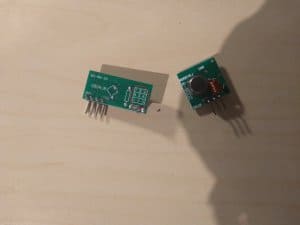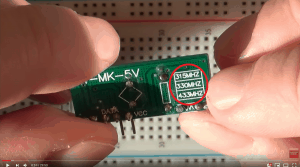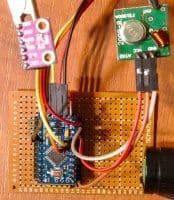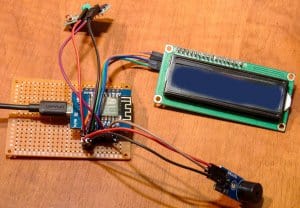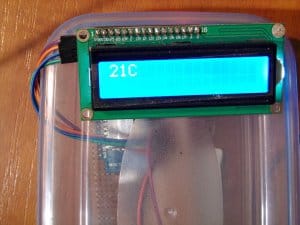Przeszukaj forum
Pokazywanie wyników dla tagów 'RF433'.
Znaleziono 3 wyniki
-
Cześć Niedawno kupiłem na Botlandzie moduł radiowy nadajnik FS100A + odbiornik 433 MHz. Cały dzień pracowałem nad jego podłączeniem. Korzystałem z przykładów biblioteki VirtualWire.h oraz podłączyłem nadajnik do pinu 12 i odbiornik do pinu 11 (do osobnych płytek). Nie potrafiłem odebrać komunikatu. Czy błąd leży gdzieś po mojej stronie czy zwyczajnie nadajnik i odbiornik nie współpracują ze sobą i powinienem dokonać zwrotu? Przykład z biblioteki VirtualWire //NADAJNIK // transmitter.pde // // Simple example of how to use VirtualWire to transmit messages // Implements a simplex (one-way) transmitter with an TX-C1 module // // See VirtualWire.h for detailed API docs // Author: Mike McCauley (mikem@open.com.au) // Copyright (C) 2008 Mike McCauley // $Id: transmitter.pde,v 1.3 2009/03/30 00:07:24 mikem Exp $ #include <VirtualWire.h> #undef int #undef abs #undef double #undef float #undef round void setup() { Serial.begin(9600); // Debugging only Serial.println("setup"); // Initialise the IO and ISR vw_set_ptt_inverted(true); // Required for DR3100 vw_setup(2000); // Bits per sec } void loop() { const char *msg = "hello world"; digitalWrite(13, true); // Flash a light to show transmitting vw_send((uint8_t *)msg, strlen(msg)); vw_wait_tx(); // Wait until the whole message is gone digitalWrite(13, false); Serial.println("Wyslano!"); delay(200); } //ODBIORNIK // receiver.pde // // Simple example of how to use VirtualWire to receive messages // Implements a simplex (one-way) receiver with an Rx-B1 module // // See VirtualWire.h for detailed API docs // Author: Mike McCauley (mikem@open.com.au) // Copyright (C) 2008 Mike McCauley // $Id: receiver.pde,v 1.3 2009/03/30 00:07:24 mikem Exp $ #include <VirtualWire.h> #undef int #undef abs #undef double #undef float #undef round void setup() { Serial.begin(9600); // Debugging only Serial.println("setup"); // Initialise the IO and ISR vw_set_ptt_inverted(true); // Required for DR3100 vw_setup(2000); // Bits per sec vw_rx_start(); // Start the receiver PLL running } void loop() { uint8_t buf[VW_MAX_MESSAGE_LEN]; uint8_t buflen = VW_MAX_MESSAGE_LEN; if (vw_get_message(buf, &buflen)) // Non-blocking { int i; digitalWrite(13, true); // Flash a light to show received good message // Message with a good checksum received, dump it. Serial.print("Got: "); for (i = 0; i < buflen; i++) { Serial.print(buf[i], HEX); Serial.print(" "); } Serial.println(""); digitalWrite(13, false); } } Mój moduł: Przykład z poradnika na YT
-
Cześć. Jestem tu dlatego że sie poddałem... Plan był taki aby za pomocą pilota 433Mhz sterować pprzekaźnikiem 2ch. Gdy mi już coś wyszło po naciśnięciu któregoś z 2 przycisków przekaźnik zaczyna wariować (załącza sie i wyłącza z 2 razy na sekunde). Szukałem gotowych kodów by znaleźć swój błąd lecz żaden nawet nie załączał przekaźnika. Niestety chce wykorzystać tylko jedno arduino nano/uno które bedzie sterowane pilotem. Może nie tyle o gotowe programy co o naprowadzenie jak to ugryźć. Posiadam: przetwornica (posiadam tez 4ch ale i tak chce wykorzystać 2) Moduł+pilot Arduino nano/uno #include <rm4.h> static const int kEnablePin = 12; static const int kData0Pin = 7; static const int kData1Pin = 8; static const int kData2Pin = 16; static const int kData3Pin = 13; const int relay1 = 10; const int relay2 = 11; const int relay3 = 14; const int relay4 = 15; RM4 remote(kData0Pin, kData1Pin, kData2Pin, kData3Pin); void setup() { Serial.begin(9600); pinMode(kEnablePin, OUTPUT); digitalWrite(kEnablePin, HIGH); pinMode(relay1, OUTPUT); pinMode(relay2, OUTPUT); pinMode(relay3, OUTPUT); pinMode(relay4, OUTPUT); } void loop() { const int button_code = remote.buttonCode(); if (button_code == 8) { digitalWrite(relay1, LOW); delay (2000); } else { digitalWrite(relay1, HIGH); } if (button_code == 2) { digitalWrite(relay2, LOW); delay (2000); } else { digitalWrite(relay2, HIGH); } if (button_code == 1) { digitalWrite(relay3, LOW); delay (2000); } else { digitalWrite(relay3, HIGH); } if (button_code == 4) { digitalWrite(relay4, LOW); delay (2000); } else { digitalWrite(relay4, HIGH); } } Z góry dzięki za pomoc
-
Mamy budynek gospodarczy oddalony od domu o kilka(naście) metrów i chcemy upewnić się, że panują tam warunki odpowiednie dla zwierząt. Jak do tej pory nasze kury nie były zainteresowane dostępem do Internetu, nie mamy więc tam zasięgu sieci WiFi. Musimy więc jakoś "podkablować radiowo" dane i zaprezentować je w naszym pokoju. Założeniami projektu, o który prosił mnie kolega było: bezprzewodowe transmitowanie danych z czujnika do domu, przy czym sam czujnik "nie ma dostępu do Internetu" wyświetlanie aktualnego odczytu na LCD oraz aktywacja alarmu w razie spadku temperatury poniżej zadanej wartości zapisywanie wyników na stronie WWW dostępnej poprzez Internet, dzięki czemu warunki można sprawdzać będąc poza domem Czujnik z nadajnikiem Nadajnik zasilany jest "kradnąc" prąd ze stale włączonego zasilacza instalacji alarmowej. Dlatego też konieczne było zastosowanie przetwornicy zmniejszającej napięcie do 5V. Składniki: Arduino Pro Mini 328 - 5V/16MHz termometr BMP280 moduł nadajnika RF433MHz przetwornica step-down LM2596 Pamiętajmy, że BMP280 toleruje napięcie 3.3V na linii danych, a nasze Arduino wykorzystuje 5V. Najlepiej więc podłączyć szynę I2C poprzez dzielnik napięcia lub konwerter poziomów logicznych. Ja wstawiłem szeregowo rezystor 4.7kΩ na obu pinach I2C, co nie jest rozwiązaniem "profesjonalnym" i zalecanym, ale (chwilowo) działa 🙂 #include <RCSwitch.h> //https://github.com/sui77/rc-switch #include <Wire.h> #include <SPI.h> #include <Adafruit_BMP280.h> Adafruit_BMP280 bmp; RCSwitch mySwitch = RCSwitch(); void setup() { Serial.begin(9600); if (!bmp.begin(0x76)) //changed from default I2C adress 0x77 { Serial.println("Nie odnaleziono czujnika BMP085 / BMP180"); while (1) { } } mySwitch.enableTransmit(10); } void loop() { int temperature = (int)bmp.readTemperature(); mySwitch.send(temperature, 24); delay(10000); } Odbiornik ESP8266 odbiera dane z modułu RF433MHz i regularnie przesyła je na stronę WWW. Stanowi ją skrypt PHP, który zapisuje do bazy danych oraz prezentuje wyniki. Wystarczy, by ESP pobrało adres skryptu i metodą GET przekazało dane (http://mojadomena.pl/skryptodbiorczy.php?haslo=tajnehaslo&temperatura=21). Składniki: ESP8266 moduł odbiornika RF433MHz wyświetlacz LCD 2x16 z konwerterem I2C LCM1602 buzzer Najtańsze moduły RF433 oferują jedynie kilkadziesiąt cm zasięgu. Musimy wykonać własną antenę z kawałka drutu, by uzyskać użyteczną komunikację. #include <ESP8266WiFi.h> #include <WiFiClient.h> #include <ESP8266WebServer.h> #include <ESP8266HTTPClient.h> #include <RCSwitch.h> //https://github.com/sui77/rc-switch #include <Wire.h> #include <LiquidCrystal_I2C.h> //https://github.com/fdebrabander/Arduino-LiquidCrystal-I2C-library #define MinimumTemperature 16 #define TempAlarmPin D1 LiquidCrystal_I2C lcd(0x27, 16, 2); HTTPClient httpc; const char* ssid = ""; const char* password = ""; const String accesspassword = "nojakieshaslo"; const String scripturl = "http://domena.saf/receivedata.php"; const char* WiFiHostname = "kurnik"; unsigned long lastTimeLCD = 0; int temperature = 0; RCSwitch mySwitch = RCSwitch(); void setup() { pinMode(TempAlarmPin, OUTPUT); digitalWrite(TempAlarmPin, LOW); Serial.begin(9600); Wire.begin(D3, D4); Wire.setClock(100000); lcd.begin(); lcd.backlight(); mySwitch.enableReceive(4); // D2 pinMode(13, OUTPUT); WiFi.hostname(WiFiHostname); WiFi.softAPdisconnect(); WiFi.disconnect(); WiFi.mode(WIFI_STA); WiFi.begin(ssid, password); } void loop() { if (mySwitch.available()) { temperature = mySwitch.getReceivedValue(); Serial.print("Received "); Serial.println(temperature); mySwitch.resetAvailable(); if (temperature <= MinimumTemperature) { digitalWrite(TempAlarmPin, HIGH); } else { digitalWrite(TempAlarmPin, LOW); } } if (lastTimeLCD == 0 || millis() - lastTimeLCD >= 60000) { lastTimeLCD = millis(); lcd.clear(); lcd.print(String(temperature) + "C"); String url = scripturl + "?password=" + accesspassword + "&temperature=" + temperature; httpc.begin(url); int httpCode = httpc.GET(); //Send the request if (httpCode > 0) { //Check the returning code String payload = httpc.getString(); //Get the request response payload Serial.println(payload); } } } Skrypt PHP: <?php DEFINE ('DB_USER', ''); DEFINE ('DB_PASSWORD',''); DEFINE ('DB_HOST','localhost'); DEFINE ('DB_NAME',''); DEFINE ('DB_TABLE_NAME','zagroda'); DEFINE ('PasswordToSave','nojakieshaslo'); $variables = array( array("temperature", "float"), ); for($i = 0; $i < count($variables); $i++) { if($_REQUEST[$variables[$i][0]] != "") { $savetodatabase = 1; break; } } try{ $pdo = new PDO('mysql:host='.DB_HOST.';dbname='.DB_NAME.';port=3306', DB_USER, DB_PASSWORD); //echo 'Connected to database'; }catch(PDOException $e){ echo 'Cannot connect to database<br />'; } $pdo->setAttribute(PDO::ATTR_ERRMODE, PDO::ERRMODE_EXCEPTION); if($savetodatabase && $_REQUEST["password"] == PasswordToSave) { if(!tableExists($pdo, DB_TABLE_NAME)){ $query= "CREATE TABLE ".DB_TABLE_NAME." (ID int NOT NULL AUTO_INCREMENT, "; for($i = 0; $i < count($variables); $i++) { $query= $query.$variables[$i][0]." ".$variables[$i][1].", "; } $query= $query."update_time BIGINT, PRIMARY KEY (ID))"; $pdo->exec($query); //echo '<br><br>'.$query.'<br><br>'; } $query="INSERT IGNORE INTO ".DB_TABLE_NAME." (ID,"; if($_REQUEST["temperature"] != ""){ $query = $query."temperature,update_time"; } $query= $query.") VALUES (1,"; if($_REQUEST["temperature"] != ""){ $query = $query."'".mysql_real_escape_string($_REQUEST["temperature"])."',"; } $query= $query."'".time()."') ON DUPLICATE KEY UPDATE "; if($_REQUEST["temperature"] != ""){ $query = $query."temperature=VALUES(temperature),update_time=VALUES(update_time)"; } //echo '<br><br>'.$query.'<br><br>'; $pdo->exec($query); } else { if($_REQUEST["values"] == "1"){ $query="SELECT * FROM `".DB_TABLE_NAME."` ORDER BY `ID` DESC LIMIT 10"; $stmt = $pdo -> query($query); $row = $stmt->fetch(/* PDO::FETCH_ASSOC */); echo $row[1].';'.$row[2].';'; $stmt->closeCursor(); } else{ echo '<html><head><meta charset="UTF-8"><title>Chicken coop</title></head> <body><table border="3"> <tr><td><b>Temperature</b></td> <td><b>Time</b></td></tr> <tr><td><span id="temp"></span>°C</td> <td><span id="time"></span></td></tr> </table> <script>myTimer();var myVar = setInterval(myTimer, 3000);function myTimer() { var xhttp = new XMLHttpRequest(); xhttp.onreadystatechange = function() { if (this.readyState == 4 && this.status == 200) { var str = this.responseText; var values = str.split(";"); document.getElementById("temp").innerHTML = values[0]; document.getElementById("time").innerHTML = Unix_timestamp(values[1]); } }; xhttp.open("GET", "receivedata.php?values=1", true); xhttp.send();} function Unix_timestamp(t) { var dt = new Date(t*1000); var day = dt.getDate(); var month = "0" + (dt.getMonth()+1); var year = dt.getFullYear(); var hr = dt.getHours(); var m = "0" + dt.getMinutes(); var s = "0" + dt.getSeconds(); return day+ "." + month.substr(-2) + "." + year + " " + hr+ ":" + m.substr(-2) + ":" + s.substr(-2); } </script> </body></html>'; } } function tableExists($pdo, $table) { try { $result = $pdo->query("SELECT 1 FROM $table LIMIT 1"); } catch (Exception $e) { return FALSE; } return $result !== FALSE; } ?> Jeżeli zechcemy dopisać do tego zapisywanie historii (przy obecnych założeniach projektu prezentowany jest jedynie najnowszy odczyt) i wykres zmian w czasie, polecam zapoznać się z biblioteką Google Charts. Przykład jej wykorzystania razem z AJAXem. Możemy również wykonać kolejny wyświetlacz np do innego pokoju czy nawet innego budynku, który odczytywał będzie wartości ze wspomnianej strony WWW. Wykorzystałem do tego znane nam ESP oraz wyświetlacz siedmiosegmentowy sterowany chipem MAX7219. #include <ESP8266WiFi.h> #include <WiFiClient.h> #include <ESP8266HTTPClient.h> #include <ESP8266WebServer.h> #include <EEPROM.h> #include "LedControl.h" //http://github.com/wayoda/LedControl #include <MD5Builder.h> #define WiFimodeButton 14 //D5 String scripturl = ""; String ssid = "", pass = ""; String host, url, http; const int httpPort = 80; const char* WiFiHostname = "Henhouse"; const String accesspassword = "nojakieshaslo"; unsigned long lastTimeLCD = 0, lastDataRead; unsigned int intervalDataRead = 5; WiFiClient client; ESP8266WebServer server(80); HTTPClient httpc; // EasyESP or NodeMCU Pin D8 to DIN, D7 to Clk, D6 to LOAD, no.of devices is 1 LedControl lc = LedControl(D8, D7, D6, 1); void setup() { pinMode(WiFimodeButton, INPUT_PULLUP); Serial.begin(9600); /* The MAX72XX is in power-saving mode on startup, we have to do a wakeup call */ lc.shutdown(0, false); /* Set the brightness to a medium values */ lc.setIntensity(0, 1); /* and clear the display */ lc.clearDisplay(0); EEPROM.begin(512); EEPROM.get(0, intervalDataRead); WiFi.softAPdisconnect(); WiFi.disconnect(); int i; if (ssid == "") { for (i = 100; i < 170; i++) { if (EEPROM.read(i) == NULL) { break; } ssid += char(EEPROM.read(i)); } for (i = i + 1; i < 250; i++) { if (EEPROM.read(i) == NULL) { break; } pass += char(EEPROM.read(i)); } } if (scripturl == "") { for (i = i + 1; i < 450; i++) { if (EEPROM.read(i) == NULL) { break; } scripturl += char(EEPROM.read(i)); } } if (digitalRead(WiFimodeButton) == LOW) { //access point part Serial.println("Creating Accesspoint"); IPAddress apIP(192, 168, 1, 1); WiFi.mode(WIFI_AP); WiFi.softAPConfig(apIP, apIP, IPAddress(255, 255, 255, 0)); WiFi.softAP("aquarium", "aquarium123"); Serial.print("IP address:\t"); Serial.println(WiFi.softAPIP()); } else { //station part Serial.print("connecting to..."); Serial.println(ssid); WiFi.hostname(WiFiHostname); WiFi.mode(WIFI_STA); WiFi.begin(ssid.c_str(), pass.c_str()); /* while (WiFi.status() != WL_CONNECTED) { delay(500); Serial.print("."); } */ Serial.println(""); Serial.println("WiFi connected"); Serial.println("IP address: "); Serial.println(WiFi.localIP()); } server.on("/", handleRoot); server.on("/login", handleLogin); const char * headerkeys[] = {"Cookie"} ; size_t headerkeyssize = sizeof(headerkeys) / sizeof(char*); //ask server to track these headers server.collectHeaders(headerkeys, headerkeyssize); server.begin(); } void loop() { if (lastDataRead == 0 || (millis() - lastDataRead >= intervalDataRead * 1000)) { //host = scripturl.substring(0, scripturl.indexOf('/')); httpc.begin("http://" + scripturl + "?values=1"); //Specify request destination int httpCode = httpc.GET(); //Send the request if (httpCode > 0) { //Check the returning code String payload = httpc.getString(); //Get the request response payload Serial.println(payload); //Print the response payload String temperature1 = explode(';', payload, 0); //String temperature2 = explode(';', payload, 2); Serial.print(temperature1); //Serial.print(" "); //Serial.println(temperature2); lc.clearDisplay(0); auto printLED = [](unsigned char beginLEDsegment, String printString)->void { int i; for (i = 0; i < printString.length(); i++) { lc.setChar(0, beginLEDsegment - i, (printString[i] == '.') ? printString[i + 1] : printString[i], (printString[i + 1] == '.') ? true : false); if (printString[i] == '.') { break; } } //lc.setChar(0, beginLEDsegment - i - 1, 'C', false); lc.setRow(0, beginLEDsegment - i - 1, B01001110); //"C" }; printLED(7, String(temperature1)); //printLED(3, String(temperature2)); if (payload.length() > 4) { lastDataRead = millis(); } else { lastDataRead += 1000; } } httpc.end(); } server.handleClient(); } void handleRoot() { if (!is_authentified()) { server.sendHeader("Location", "/login"); server.sendHeader("Cache-Control", "no-cache"); server.send(301); return; } int i; if (server.hasArg("SSID") && server.arg("SSID") != "" && server.hasArg("wifipass") && server.arg("wifipass") != "") { ssid = server.arg("SSID"); pass = server.arg("wifipass"); for (i = 0; i < server.arg("SSID").length(); i++) { EEPROM.write(i + 100, server.arg("SSID")[i]); } i += 100; EEPROM.write(i, NULL); for (i = 0; i < server.arg("wifipass").length(); i++) { EEPROM.write(i + 101 + server.arg("SSID").length(), server.arg("wifipass")[i]); } //i += 3 + server.arg("wifipass").length(); EEPROM.write(server.arg("SSID").length() + server.arg("wifipass").length() + 101, NULL); EEPROM.commit(); } if (server.hasArg("scripturl") && server.arg("scripturl") != "") { scripturl = server.arg("scripturl"); for (i = 0; i < scripturl.length(); i++) { EEPROM.write(i + 102 + ssid.length() + pass.length(), scripturl[i]); } EEPROM.write(ssid.length() + pass.length() + scripturl.length() + 102, NULL); EEPROM.commit(); } if (server.arg("intervalDataRead").toInt() > 0) { intervalDataRead = server.arg("intervalDataRead").toInt(); EEPROM.put(0, intervalDataRead); EEPROM.commit(); } if (server.hasArg("SSID") && server.arg("SSID") != "" && server.hasArg("wifipass") && server.arg("wifipass") != "") { ESP.restart(); } String content = "<html><head><title>Henhouse</title></head><body>"; content += "<form action='/' method='POST'>Home WiFi Network Name (SSID): <input type='text' name='SSID' value='" + String(ssid) + "'><br>"; content += "Password: <input type='password' name='wifipass'><br>"; content += "URL to datalogging script (without http://): <input type='text' name='scripturl' id='scripturl' value='" + scripturl + "'><br>"; content += "Read values every [seconds]: <input type='text' name='intervalDataRead' value='" + String((int)intervalDataRead) + "'><br>"; content += "<script language=\"javascript\">function stringReplace() {var s = document.getElementById(\"scripturl\").value;var removeThis = /^(http?|https):\\/\\//;s = s.replace(removeThis, '');document.getElementById(\"scripturl\").value = s;}</script>"; content += "<input type='submit' value='Submit' onClick=\"stringReplace();\"></form><br>"; content += "</body></html>"; server.send(200, "text/html", content); } bool is_authentified() { Serial.println("Enter is_authentified"); if (server.hasHeader("Cookie")) { Serial.print("Found cookie: "); String cookie = server.header("Cookie"); Serial.println(cookie); String cookielogin = "WEATHERSTATION=" + md5(accesspassword); if (cookie.indexOf(cookielogin) != -1) { Serial.println("Authentification Successful"); return true; } } Serial.println("Authentification Failed"); return false; } void handleLogin() { String msg; if (server.hasHeader("Cookie")) { Serial.print("Found cookie: "); String cookie = server.header("Cookie"); Serial.println(cookie); } if (server.hasArg("DISCONNECT")) { Serial.println("Disconnection"); server.sendHeader("Location", "/login"); server.sendHeader("Cache-Control", "no-cache"); server.sendHeader("Set-Cookie", "WEATHERSTATION=0"); server.send(301); return; } if (server.hasArg("PASSWORD")) { if (server.arg("PASSWORD") == accesspassword) { server.sendHeader("Location", "/"); server.sendHeader("Cache-Control", "no-cache"); String cookielogin = "WEATHERSTATION=" + md5(accesspassword); server.sendHeader("Set-Cookie", cookielogin); server.send(301); Serial.println("Log in Successful"); return; } msg = "Wrong username/password! try again."; Serial.println("Log in Failed"); } String content = "<html><body><form action='/login' method='POST'>"; content += "Password:<input type='password' name='PASSWORD' placeholder='password'><br>"; content += "<input type='submit' name='SUBMIT' value='Submit'></form>" + msg + "<br>"; server.send(200, "text/html", content); } String md5(String str) { MD5Builder _md5; _md5.begin(); _md5.add(String(str)); _md5.calculate(); return _md5.toString(); } String explode(char character, String string, unsigned int position) { unsigned int i, ii; unsigned int counter = 0; for (i = 0; i < string.length(); ++i) { if (string[i] == character) { counter++; i++; } if (counter >= position) { break; } } for (ii = i + 1; ii < string.length(); ii++) { if (string[ii] == character) { break; } } return string.substring(i, ii); }

